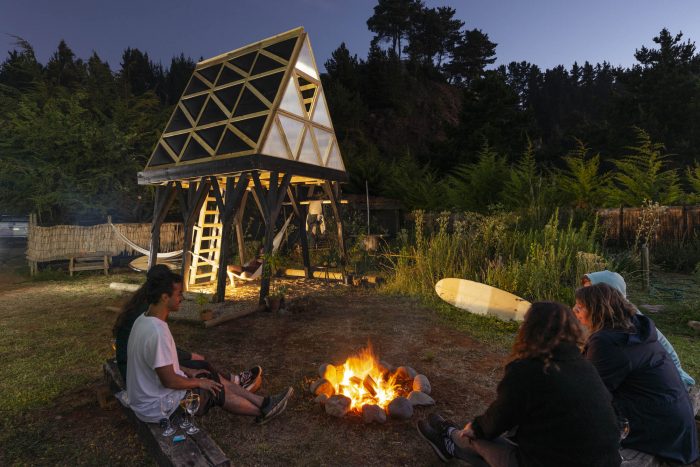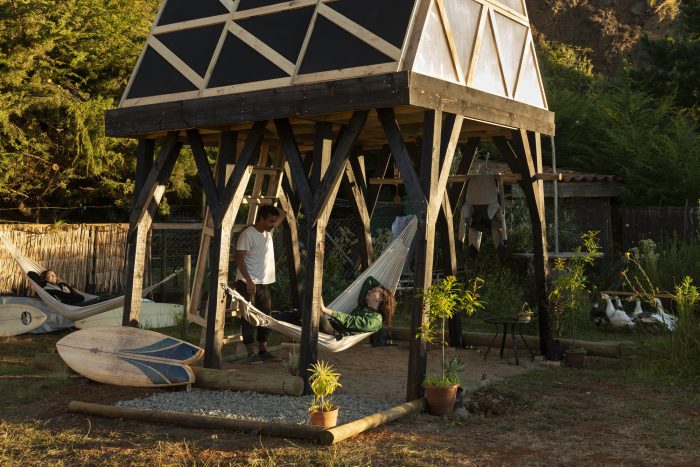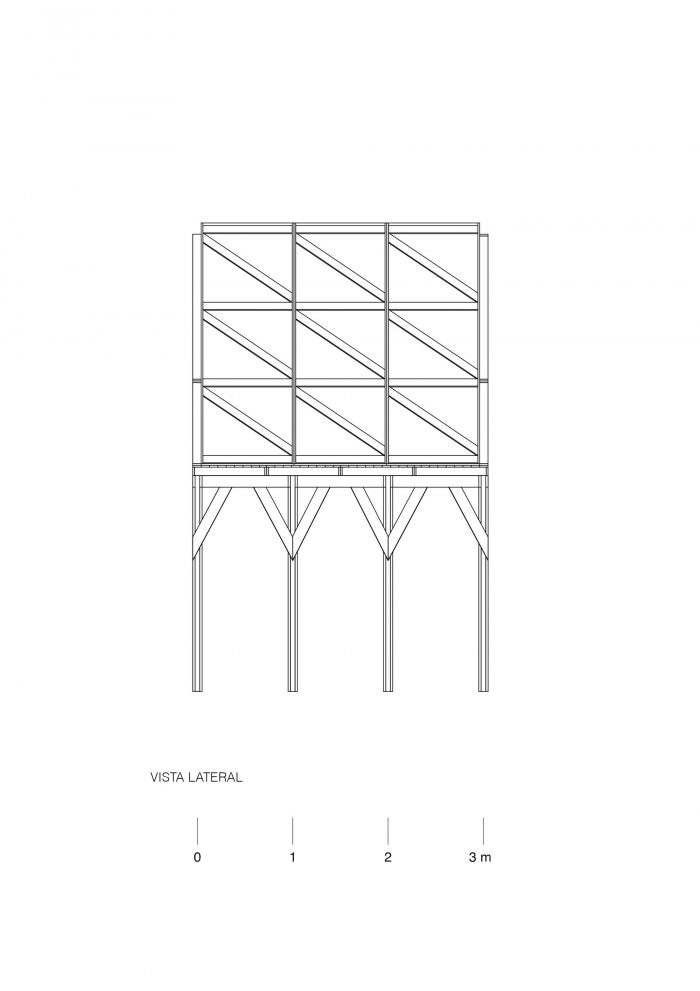在智利佩卢胡埃镇的海岸上有一个 “Puntas del Maule “冲浪营地。它位于该地区海岸的中部,其特点是各种各样的陆地山脊进入大海,面对来自太平洋的海浪。这种情况创造了一个陡峭的悬崖景观,茂密的植被和公认的国际质量的海浪,吸引了来自世界各地的冲浪者。
On the Chilean coast of the town of Pelluhue is the “Puntas del Maule” surf camp. Located in the middle of the coast of this region, characterized by the great variety of land ridges that go into the sea-facing the waves coming from the Pacific Ocean. This condition creates a landscape of steep cliffs, lush vegetation and waves of recognized international quality, attracting surfers from all over the world.
在这种情况下,与这个空间的所有者一起,我们决定在旅游项目 “Puntas del Maule “中安装一个原型,我们称之为 “基本房”(第二次迭代)。这是一个测试模型,适合短期逗留。这个联盟,一方面为冲浪营地的扩建提供了一个解决方案,另一方面,可以直接测试Fundamental Room原型所面临的持续风和高湿度的影响。这一次采用了新的保温层和一个将其与地面隔开的桩基。
In this context and together with the owners of this space, we decided to install in the tourist project “Puntas del Maule”, the prototype that we call Fundamental Room (in its second iteration). A test model, conditioned for short stays. This alliance, on the one hand, provides a solution to a requirement for the expansion of the surf camp and, on the other, allows to directly test the effects of constant wind and the high humidity levels that the Fundamental Room prototype faces. This time with a new thermal insulation skin and a base of piles that separate it from the ground.
庇护所的每个面都是基于预制板设计的,由总共21个调制元件组成。6个用于屋顶,3个用于地板,8个用于桩基,4个用于正面。缩小到大约3×1.5×2米的包装,允许用小型卡车运输,组装时间为2.5天。
Each of the faces of the shelter is designed based on prefabricated panels made up of a total of 21 modulated elements: 6 for roof, 3 for floor, 8 for piles and 4 frontal. Reduced to a package of approximately 3 x 1.5 x 2 m. Allowing the transfer in a small truck, with an assembly time of 2 and a half days.
这些面板是根据热绝缘来定义的。它们相当于一个用防水橡胶布覆盖的房间,有12厘米厚的垫子,安装在每个组成倾斜面的木板和避难所的水平框架中。对于构成光输入的前墙的面,我们认为有一个由双肺泡聚碳酸酯室组成的保温层,在它们之间保留了一个空气空间。在这个面板的中心,有一个三角形的窗户,用同样的原理制作,2层3毫米的丙烯酸,构成一个6厘米厚的空气室。根据同样的预制构件的逻辑来构思,8根桩子把小屋抬起来,由4个框架组成,用被称为Shou Sugi Ban的木材表面燃烧技术来处理,这是一种传统的日本装饰,通过表面的碳化,可以防止气候和生物制剂对木材的破坏。基本房间被理解为渐进模块系统中的基本单元。这是为城市中心的孤立地区提供的一个缩小的生活模式。
The panels were defined based on thermal insulation. They correspond to a chamber covered in waterproof rubberized fabric, with 12 cm thick mats, installed in each of the wooden panels that make up the inclined planes and the horizontal framework of the refuge. For the faces that make up the front walls that carry the light inputs, a thermal insulation consisting of a double alveolar polycarbonate chamber was thought, conserving an air space between them. In the center of this panel, there is a triangular window made with the same principle, 2 layers of 3 mm acrylic that make up a 6 cm thick air chamber. Conceived under the same logic of prefabricated elements, the 8 piles that raise the cabin were incorporated, consisting of four frames treated with the surface burning technique of wood known as Shou Sugi Ban, a traditional Japanese finish that allows by carbonization of the surface a type of protection against climatic and biological agents that damage wood. Fundamental Room is understood as the basic unit within a system of progressive modules. A reduced living model for isolated areas of urban centers.
Architects: República Portátil
Area: 9 m²
Year: 2018
Photographs: Gino Zavala
Design Team Collaborators:Camila Constanza Sánchez Rain, Karla Belén Regner Berríos, Dominique Kovacevic Vera, Renata Caterina Dapelo Valenzuela, Felipe Andrés Lavín Maulén, Matías Antonio Rojas Becerra, Paul Sanxi Giroux Bravo, Juan Esteban Soto Faundez, Camilo Aravena
City:Maule
Country:Chile





















